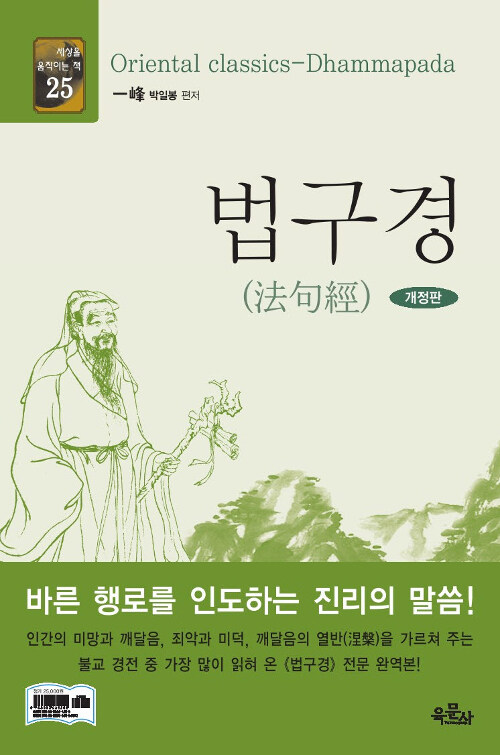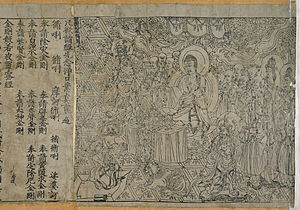법구경 - 개정판 세상을 움직이는 책 25


박일봉 (엮은이)육문사2019-04-15








































정가
25,000원
판매가
22,500원 (10%, 2,500원 할인)
책소개
법구존자가 엮은 것으로, 오나라의 유기난이 번역한 것이다. 법구존자는 파사사대논사의 한 사람으로 부처님이 돌아가신지 300년 뒤에 세상에 태어났다고 하며, 대덕법구라는 인물이다. <법구경>에는 남전과 북전의 두 종류가 있다. 남전은 파리어로 번역된 법구경으로 26품 422송으로 되어 있으며, 북전은 범어를 번역한 것으로 39품 752송으로 되어 있다.
이 법구경을 번역한 유기난은 천축의 중이다. 그의 전기에 의하면 삼장에 밝고, 특히 아함경에 밝아 뒤에 서역으로부터 중국에 와서 위나라 문제 황무 3년에 입률염과 법구경을 번역했다. 제1 무상품으로부터 제39 길상품에 이르는 것을 모두 번역한 것으로 간단하기는 하지만 불교 전체의 내용을 보여 주고 있으며 실제로 인간생활의 여러 분야에 걸쳐 다 포함되어 있다. <논어>나 <채근담>과 마찬가지로, 사람이 세상을 살아가는데 있어서 처세를 어떻게 하느냐에 대한 말씀이다.
목차
序文 ……………………………………………………………… 4
제1 무상품(無常品) …………………………………………… 8
제2 교학품(敎學品) …………………………………………… 23
제3 다문품(多聞品) …………………………………………… 44
제4 독신품(篤信品) …………………………………………… 58
제5 계신품(誡愼品) …………………………………………… 70
제6 유념품(愉念品) ………………………………………… 81
제7 자인품(慈仁品) ………………………………………… 90
제8 언어품(言語品) ………………………………………… 102
제9 쌍요품(雙要品) ………………………………………… 111
제10 방일품(放逸品) ………………………………………… 126
제11 심의품(心意品) ………………………………………… 140
제12 화향품(華香品) ………………………………………… 148
제13 우암품(愚闇品) ………………………………………… 159
제14 명철품(明哲品) ………………………………………… 173
제15 나한품(羅漢品) ………………………………………… 184
제16 술천품(述千品) ………………………………………… 192
제17 악행품(惡行品) ………………………………………… 202
제18 도장품(刀杖品) ………………………………………… 217
제19 노모품(老耗品) ………………………………………… 227 더보기
저자 및 역자소개
박일봉 (엮은이)
고려대학교 문과대학 국어국문학과를 졸업하고 동 대학원 문학석사과정을 수료했다. 고려대학교, 육군사관학교, 수도여자사범대학 강사를 역임하였다. 역서로는 <논어>, <맹자>, <대학.중용>, <사서입문>, <채근담>, <명심보감>, <손자병법>, <소학>, <노자 도덕경>, <법구경> 등이 있다.
최근작 : <법구경>,<고사성어>,<법구경> … 총 82종 (모두보기)
출판사 제공 책소개
바른 행로를 인도하는 진리의 말씀!
인간의 미망과 깨달음, 죄악과 미덕, 깨달음의 열반(涅槃)을 가르쳐 주는
불교 경전 중 가장 많이 읽혀 온 《법구경》 전문 완역본!
부처님을 처음 배우고 따르는 사람들이 곁에 두고 읽어야 할 책!
혼탁한 세상에 처세를 어떻게 하고 인생을 어떻게 살아가느냐를 가르쳐 주는 부처님의 광대무변(廣大無邊)한 지혜와 깊고 후한 대자비(大慈悲)를 곰곰이 생각하게 한다.
《법구경(法句經)》은 법구존자(法救尊者)가 엮은 것으로, 오(吳)나라의 유기난(維祇難)이 번역한 것이다. 법구존자는 파사사대논사(婆娑四大論師)의 한 사람으로 부처님이 돌아가신지 300년 뒤에 세상에 태어났다고 하며, 대덕법구(大德法救)라는 인물이다.
《법구경》에는 남전(南傳)과 북전(北傳)의 두 종류가 있다.
이 법구경을 번역한 유기난은 천축(天竺)의 중〔僧〕이다. 그의 전기에 의하면 삼장(三藏)에 밝고, 특히 아함경(阿含經)에 밝아 뒤에 서역(西域)으로부터 중국에 와서 위(魏)나라 문제(文帝) 황무(黃武) 3년에 입률염(笠律炎)과 법구경을 번역했다.
이 법구경은 제1 무상품(無常品)으로부터 제39 길상품(吉祥品)에 이르는 것을 모두 번역한 것으로 간단하기는 하지만 불교 전체의 내용을 보여 주고 있으며 실제로 인간생활의 여러 분야에 걸쳐 다 포함되어 있다.
《법구경(法句經)》은 《논어(論語)》나 《채근담(菜根譚)》과 마찬가지로, 사람이 세상을 살아가는데 있어서 처세를 어떻게 하느냐에 대한 말씀이다.
처음에 불교가 무엇인지를 알려는 사람에게 이 《법구경》이야말로, 불교를 배우는데 경시할 수 없는 것으로 국제적인 불교의 경전으로 널리 읽힌다.
신앙이 있는 사람이나 없는 사람이나, 더러움으로 썩어버린 인간계의 욕정을 없애서 깨끗한 생활을 하고, 올바른 인생의 종국이 깨달음의 열반이라는 부처님의 높고 큰 이상을 보여 준다. 사람은 반드시 죽지만, 불법(佛法)은 인생이 어떻게 살아가느냐를 가르쳐 주고 있다.
이밖에도 널리 전해지는 《화엄경(華嚴經)》 · 《반야경(般若經)》 · 《법화경(法華經)》 · 《열반경(涅槃經)》 등 8만 4천 가지 불경이 있지만, 이 《법구경》은 주로 《아함경(阿含經)》에서 중요한 부분을 정리한 것으로 매우 알기 쉽다.
序文
《법구경(法句經)》은 《논어(論語)》나 《채근담(菜根譚)》과 마찬가지로, 사람이 세상을 살아가는데 있어서 처세를 어떻게 하느냐에 대한 말씀이다.
《법구경》은 법구존자(法救尊者)가 엮은 것으로 吳나라의 유기난(維祇難)이 번역한 것이다. 법구존자는 파사사대논사(婆娑四大論師)의 한 사람으로 부처님이 돌아가신지 300년 뒤에 세상에 태어났다고 하며, 대덕법구(大德法救)라는 인물이다.
《법구경》에는 남전(南傳)과 북전(北傳)의 두 종류가 있다. 남전은 파리어로 번역된 법구경으로 26品 422송(頌)으로 되어 있으며, 북전은 범어(梵語)를 번역한 것으로 39品 752송(頌)으로 되어 있다.
이 법구경을 번역한 유기난은 천축(天竺)의 중〔僧〕이다. 그의 전기에 의하면, 삼장(三藏)에 밝고, 특히 아함경(阿含經)에 밝아, 뒤에 서역(西域)으로부터 중국에 와서 위(魏)나라 문제(文帝) 황무(黃武) 3년에 입률염(笠律炎)과 법구경을 번역했다.
이 법구경은 제1 무상품(無常品)으로부터 제39 길상품(吉祥品)에 이르는 것을 모두 번역한 것으로, 간단하기는 하지만 불교 전체의 내용을 보여 주고 있으며, 실제로 인간생활의 여러 분야에 걸쳐 다 포함되어 있다.
인간의 미망과 깨달음, 죄악과 미덕, 깨달음의 열반(涅槃)을 이해할 수 있으며, 자유방임주의시대에 사는 현대에 마음과 몸을 조이는 생각을 곰곰이 생각하게 한다.
신앙이 있는 사람이나 없는 사람이나, 특히 음욕을 굳게 경계하는 일 등은 고마운 교훈이다. 더러움으로 썩어버린 인간계의 욕정을 없애서 깨끗한 생활을 하고, 올바른 인생의 종국이 깨달음의 열반이란 것을 보여 주는 것은, 근본적으로 불교의 높은 큰 이상을 보여 주는 것이라고 믿고 있는 것이다.
처음에 불교가 무엇인지를 아는 사람에게 있어서, 이 법구경이야말로 불교를 배우는데 있어서도 경시할 수 없는 것으로, 전혀 국제적인 불교의 경전으로써 널리 읽혀도 좋다고 확신하는 바이다.
이밖에도 널리 전하여지는 화엄경(華嚴經) · 반야경(般若經) · 법화경(法華經) · 열반경(涅槃經) 등 8만 4천 가지 불경이 있거니와, 대부분이 이해하기 어려워서 한 번이나 두 번 읽어 가지고는 이해하기 어렵다.
이 법구경은 주로 아함경(阿含經)에서 중요한 부분을 정리한 것으로 매우 알기 쉽다.
부처님의 광대무변(廣大無邊)한 지혜와 깊고 후한 대자비(大慈悲)를 알게 되면, 우리들과 같은 평범한 사람들은 천박하지도 슬프지도 않은, 눈앞에 나타난 현상에만 사로잡혀 미혹됨을 깊이 깨닫게 될 것이다. 사람은 반드시 죽어 가거니와, 불법(佛法)은 인생이 어떻게 살아가느냐를 가르쳐 주고 있다. 접기








